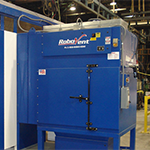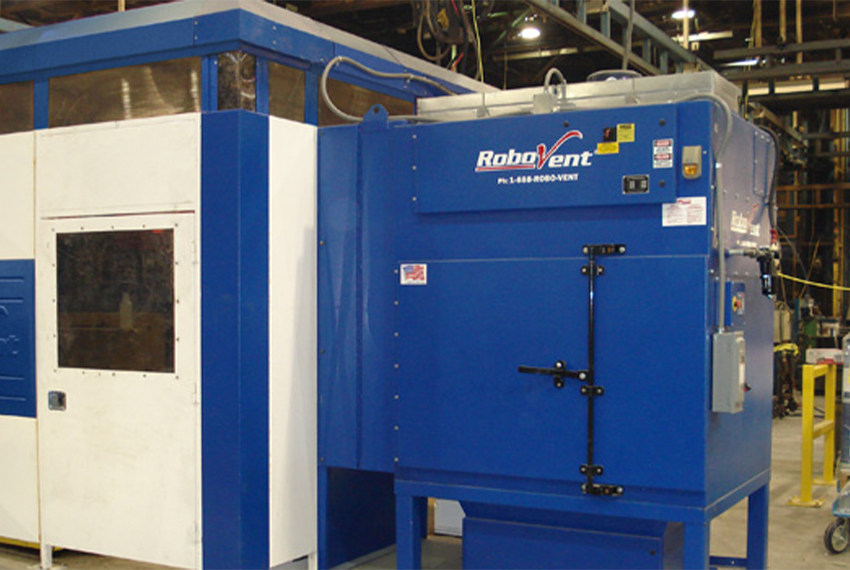Bobcat: Surpassing Industry Standards for Clean Air
Featured Solution: Senturion
Other Solutions: Fusion
Industries: Heavy Equipment
Applications: Laser Cutting, Metalworking, Robotic Welding

Bobcat's U.S.-based plant manufactures skid-steer loaders, loaders, compact loaders, mini-excavators and other utility vehicles which are sold to dealerships worldwide. Much of the welding portion of the manufacturing process is performed by a unique system of modular robotic equipment.
Michels became involved in the filtration manufacturer search when it became apparent that a new, modular robotic welding system was not being utilized due to the time it was taking to get a filtration system specifically designed and built for this system.
“We have always been concerned about air filtration and providing a healthy working environment for our employees,” said Michels. “However, our previous systems were very inflexible, and we quickly found out that wouldn't work with our new modular system.”
“Most of the systems we looked at were one-of-a-kind, large systems that needed to be installed in the ceiling or on the roof,” said Michels. “They were too large, complicated and difficult to maintain for what we wanted to accomplish. We wanted something that could be moved with our units and that was easy to implement and maintain.”
This particular plant has been in operation for 50 years, 30 of which the company has used robotic welding. And, the company has always had some form of air-filtration system in place. The electrostatic ambient air-filtration system the company started out with all those years ago would cause the dust and dirt to cling to the metal systems causing the plant to look dirty and dingy. Then, the company decided to install air-filtration units on the individual weld cells. Three or four versions of this system proved that the company needed a system designed to meet their needs because the off-the-shelf systems were not designed to handle the amount of weld smoke produced by their units.
“Commercially built systems just were not able to meet our high standard,” said Michels. “We needed something specifically built to meet our needs and goals for the healthy working environment we want to provide to our employees.”
Bobcat has always been within Occupational Safety and Health Administration (OSHA) limits for clean air, but that still wasn't enough for the company. They wanted to surpass industry standards and do everything possible to protect their weld operators from weld smoke.
“Ethically, this was the right thing to do for our employees,” said Michels. “Our commitment to our employees is to provide a safer and healthier workplace than what the government mandates. We have won some fairly significant awards from national organizations for our environmental and safety work. We know we are doing the right thing.”
The RoboVent system was the last system Michels and Bobcat looked at. One of the company's manufacturing engineers happened to see the system at a trade show and became convinced that it was the right system and that it would accomplish all the goals Bobcat wanted to achieve with an airfiltration system.
"We had some very stringent specifications for an air filtration system, and RoboVent was the answer to a majority of them,” said Michels.
Bobcat had discussed their air-filtration needs with as many as 12 other companies who all claimed they could perform as well if not better than what the company has now with the RoboVent system. According to Michels, this is because RoboVent was built from the ground up specifically to meet Bobcat's needs.
Bobcat has installed 40 to 50 of the RoboVent systems both on new and old welding cells. According to Michels, this system can be installed and maintained quicker than any other air-filtration system Bobcat had previously used.
“They install quicker and are fairly easy to modify,” said Michels. “In addition, the RoboVent filters last longer than any others I have dealt with over the years.”
In some cases, Bobcat's previous systems had filters that had to be changed every two to three weeks. With RoboVent, filters are now being changed about every nine months.
Because of the ease of use and the company's commitment to its employees' health, Bobcat has mandated that they will not start a robotic welding system without an air-filtration system being installed.
“The unique aspect of the RoboVent system is that it is not just a venting hood – it is an entire system that pulls the smoky air away from our operators,” said Michels. “We strongly feel that this is the best solution for our employees.”
An additional benefit that Michels likes is the ability for Bobcat employees to reconfigure and reinstall the RoboVent systemthemselves. This allows for more flexibility on the manufacturing floor.
“We selected the RoboVent product because of our need for an air-filtration system that allows for flexibility while providing the maximum amount of safety for our employees,” said Michels. “RoboVent was willing to design a solution just for us. They worked closely with us to make sure they met all our needs.”
Michels is very pleased with the success the new air-filtration system has shown within the Bobcat plant. He feels the company is now providing an increased healthier atmosphere for it employees while continuing to adhere to and exceed OSHA standards for smoke ventilation.
“We are pleased to have accomplished this with the RoboVent system,” Michels said. “And we are pleased to have found such a flexible partner in RoboVent – a partner who works with us to help us achieve our goals.”






